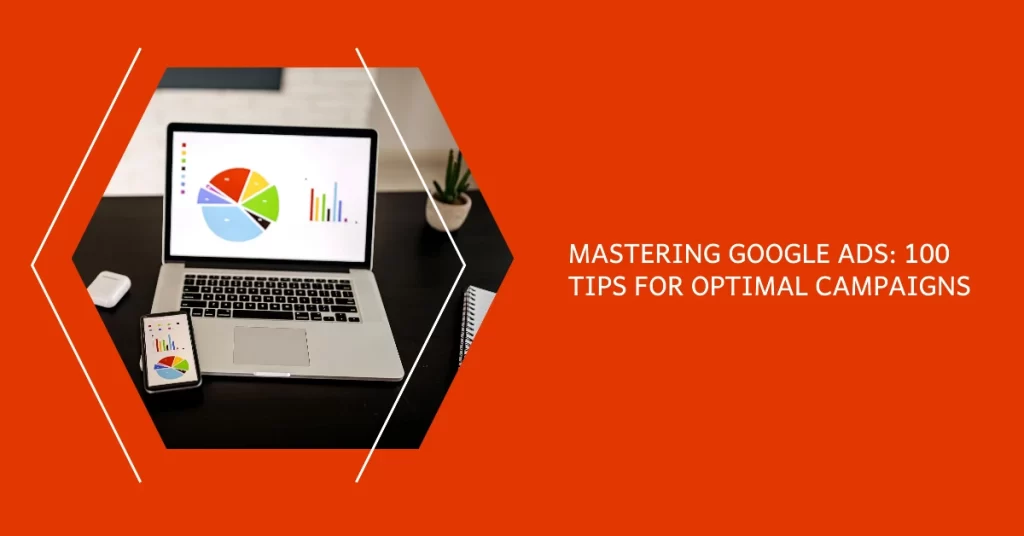Google Ads remains a cornerstone for digital advertising success, providing a platform for businesses to reach their target audience effectively. Navigating the complexities of Google Ads requires a comprehensive strategy. Here, we present 100 tips to guide you toward optimal campaigns in 2023. Each tip is not just listed but explained with practical examples to facilitate a deeper understanding.
1-10: Audience Understanding and Compelling Ad Copy
1. Understand your audience before creating ads.
Example: If targeting a younger demographic, use language and imagery that resonates with their interests and preferences.
2. Use compelling ad copy to grab attention.
Example: Instead of a generic headline, try something attention-grabbing like “Unlock Exclusive Deals Today – Limited Time Only!”
3. Utilize ad extensions for more visibility.
Example: Add site link extensions to direct users to specific product pages or service categories.
4. A/B test your ad creatives.
Example: Test two different headlines to see which one generates a higher click-through rate (CTR).
5. Optimize landing pages for conversions.
Example: Ensure a seamless transition from ad to landing page, maintaining a consistent message and design.
6. Leverage remarketing to re-engage visitors.
Example: Target users who visited your site but didn’t make a purchase with a special discount offer.
7. Set clear goals for your ad campaigns.
Example: If your goal is lead generation, focus on optimizing for form submissions rather than just clicks.
8. Monitor and adjust bid strategies regularly.
Example: Increase bids during peak hours to maximize visibility when competition is high.
9. Use negative keywords to filter out irrelevant clicks.
Example: If you sell luxury watches, use negative keywords like “cheap” to avoid attracting users searching for low-cost options.
10. Focus on quality score for better ad placements.
Example: Improve ad relevance and landing page experience to boost your quality score.
11-20: Ad Formats, Themes, and Call-to-Action Testing
11. Experiment with different ad formats.
Example: Try carousel ads to showcase multiple products within a single ad unit.
12. Keep ad groups tightly themed for relevance.
Example: For a sports apparel campaign, separate ad groups for “running shoes” and “athletic wear” for targeted messaging.
13. Test different call-to-action phrases.
Example: Compare “Shop Now” with “Discover Exclusive Deals” to determine the most effective call to action.
14. Optimize for mobile users.
Example: Ensure your landing pages are mobile-friendly to provide a seamless experience for mobile users.
15. Utilize ad scheduling for better targeting.
Example: If running a restaurant ad, schedule it to display during lunch and dinner hours for maximum impact.
16. Use ad customizers for dynamic content.
Example: Implement a countdown timer for a limited-time sale, dynamically updating based on the campaign end date.
17. Implement geo-targeting to reach specific locations.
Example: Target users within a 10-mile radius for a local business offering.
18. Test different ad placements on the Google Display Network.
Example: Evaluate the performance of in-article ads versus display ads on specific websites.
19. Utilize ad scheduling to show ads at peak times.
Example: If advertising a gaming app, schedule ads to display during evening hours when users are more likely to engage.
20. Keep abreast of industry trends.
Example: If video content is trending in your industry, consider incorporating video ads into your strategy.
21-30: Ad Copy Refresh, Website Speed, and Responsive Search Ads
21. Regularly review and update ad copy.
Example: Refresh ad copy to align with seasonal changes or current events, keeping content relevant.
22. Optimize your website for speed.
Example: Compress images and use browser caching to ensure fast-loading landing pages.
23. Utilize ad schedule bid adjustments.
Example: Increase bids during weekends or evenings when your target audience is more active.
24. Test different landing page layouts.
Example: Compare a long-form sales page to a concise, scrollable landing page to identify the most effective layout.
25. Use responsive search ads for flexibility.
Example: Create ads with multiple headlines and descriptions for automated testing and optimization.
26. Utilize the Google Ads keyword planner.
Example: Identify high-volume keywords related to your business for strategic targeting.
27. Keep an eye on your competitors’ ad strategies.
Example: Analyze competitor ads to identify unique selling points and areas for differentiation.
28. Utilize ad customizers for countdowns.
Example: Create urgency by displaying a countdown to the end of a promotional offer in your ad.
29. Incorporate emotional triggers in your ad copy.
Example: Craft ad copy that evokes emotions related to the benefits of your product or service.
30. Utilize audience targeting for more precision.
Example: Create specific ads for different audience segments based on demographics or behavior.
31-40: Search Term Reports, Ad Image Updates, and YouTube Video Ads
31. Monitor search terms reports for negative keywords.
Example: Exclude irrelevant terms from triggering your ads to enhance targeting accuracy.
32. Regularly update ad images for freshness.
Example: Keep visuals current by incorporating new product images or seasonal graphics.
33. Leverage the power of video ads on YouTube.
Example: Showcase product demonstrations or customer testimonials in engaging YouTube video ads.
34. Test different bidding strategies.
Example: Compare manual CPC with automated bidding strategies to determine the most effective for your goals.
35. Use ad rotation settings for variety.
Example: Rotate ads evenly to assess performance and identify the most effective creatives.
36. Optimize ad rotation settings for performance.
Example: Set ad rotation to prioritize the best-performing ads for increased visibility.
37. Implement ad variations for testing.
Example: Create variations of ad copy, headlines, or visuals to identify the most effective elements.
38. Utilize the Google Ads editor for bulk changes.
Example: Make bulk changes to ad copy or bid adjustments efficiently using the Google Ads editor.
39. Implement dayparting for better budget control.
Example: Adjust bids based on time of day to maximize budget during peak hours.
40. Keep ad groups focused on a single theme.
Example: For an electronics store, separate ad groups for “smartphones” and “laptops” for focused targeting.
41-50: Dynamic Keyword Insertion, Ad Extension Management, and Responsive Display Ads
41. Utilize dynamic keyword insertion in ad copy.
Example: Ensure your ad copy dynamically includes the user’s search term for increased relevance.
42. Regularly check and update ad extensions.
Example: Keep site link extensions updated with the latest product or service offerings.
43. Utilize responsive display ads for broader reach.
Example: Create responsive display ads to automatically adjust to different ad spaces for optimal visibility.
44. Test different display ad sizes.
Example: Assess the performance of square versus leaderboard display ad formats.
45. Optimize your ad copy for voice search.
Example: Craft ad copy that aligns with natural language queries for effective voice search targeting.
46. Use callout extensions for additional information.
Example: Highlight free shipping or warranty information using callout extensions for added appeal.
47. Incorporate social proof in your ad copy.
Example: Include customer reviews or ratings in ad copy for increased credibility.
48. Test different ad headlines for impact.
Example: Compare straightforward headlines with witty or humorous alternatives to identify the most engaging.
49. Utilize the Google Ads mobile app for on-the-go management.
Example: Monitor campaign performance and make quick adjustments using the Google Ads mobile app.
50. Regularly review and update ad targeting options.
Example: Adjust targeting options based on changing customer behavior or market trends.
51-60: Ad Positioning, Seasonal Elements, and Google Analytics Integration
51. Use ad scheduling for dayparting.
Example: Adjust bids during specific hours to align with when your target audience is most active.
52. Test different ad positions on the search results page.
Example: Compare the performance of ads in the top positions versus those in lower positions.
53. Incorporate seasonal elements in your ad copy.
Example: Modify ad copy to reflect seasonal promotions, holidays, or events.
54. Utilize Google Analytics for deeper insights.
Example: Integrate Google Analytics to analyze user behavior beyond ad interactions.
55. Monitor and optimize for the top-performing keywords.
Example: Allocate more budget to keywords that consistently deliver high ROI.
56. Use ad rotation settings to evenly show ads.
Example: Ensure that all ads in a group receive equal exposure for fair performance assessment.
57. Implement ad variations with emojis for attention.
Example: Add emojis to ad copy to make it visually appealing and stand out in the search results.
58. Optimize landing pages for fast load times.
Example: Compress images and minimize code for quicker landing page loading.
59. Test different ad descriptions for effectiveness.
Example: Experiment with concise versus detailed ad descriptions to gauge user response.
60. Utilize the Google Ads conversion tracking.
Example: Track specific conversion actions, such as form submissions or product purchases, for accurate performance measurement.
61-70: Promotion Types, Display Network Targeting, and Device Bid Adjustments
61. Implement ad variations with different offers.
Example: Test ads with percentage discounts versus ads promoting a free trial.
62. Test different display network targeting options.
Example: Assess the performance of contextual targeting versus placement targeting on the Display Network.
63. Use ad extensions to highlight unique selling points.
Example: Utilize callout extensions to showcase free shipping or a money-back guarantee.
64. Optimize ad copy for different devices.
Example: Tailor ad copy for mobile users with concise messaging and clear calls to action.
65. Leverage the power of Google Ads scripts.
Example: Automate bid adjustments based on weather conditions or stock market trends using Google Ads scripts.
66. Utilize in-market audiences for targeting.
Example: Target users actively researching products or services related to your business.
67. Test different ad colors for visibility.
Example: Experiment with contrasting colors to make your ads stand out on the search results page.
68. Implement ad variations with different calls-to-action.
Example: Compare “Shop Now” with “Learn More” to identify the most effective call to action.
69. Regularly review and update ad budgets.
Example: Adjust daily budgets based on campaign performance and business goals.
70. Optimize for local searches with location extensions.
Example: Include location extensions to provide users with your business address and contact information.
71-80: Device Bid Adjustments, Urgency Elements, and Gmail Ads
71. Utilize bid adjustments for device targeting.
Example: Increase bids for mobile users if your website is mobile-optimized for better user experience.
72. Implement ad variations with urgency.
Example: Include limited-time offers in your ad copy to create a sense of urgency.
73. Test different ad placements on the Google Display Network.
Example: Assess the performance of in-stream video ads versus interactive display ads.
74. Use ad rotation settings to favor top-performing ads.
Example: Set ad rotation to prioritize ads with the highest conversion rates.
75. Optimize ad copy for different demographics.
Example: Tailor messaging to appeal to the specific interests and preferences of different age groups.
76. Leverage the power of Gmail ads for email targeting.
Example: Target users based on their interests, behavior, or the content of their emails.
77. Implement ad variations with different promotions.
Example: Compare ads offering a percentage discount with those promoting a buy-one-get-one-free deal.
78. Test different ad formats for variety.
Example: Compare the performance of image ads versus interactive ads on the Display Network.
79. Utilize bid adjustments for ad position targeting.
Example: Increase bids for higher ad positions to enhance visibility on the search results page.
80. Regularly review and update ad group structure.
Example: Adjust ad group structure based on the performance of individual keywords and ad variations.
81-90: Landing Page Quality Scores, Price Variations, and Product Feature Highlights
81. Optimize landing pages for high-quality scores.
Example: Ensure landing pages align with ad copy and provide a positive user experience.
82. Implement ad variations with different prices.
Example: Test different pricing strategies, such as discounts versus value-added bundles.
83. Use ad extensions to showcase product features.
Example: Highlight specific product features, such as “water-resistant” or “eco-friendly.”
84. Test different ad sizes for display campaigns.
Example: Assess the performance of leaderboard ads versus skyscraper ads on the Display Network.
85. Utilize bid adjustments for audience targeting.
Example: Increase bids for audiences more likely to convert, such as past purchasers.
86. Monitor and optimize for the best-performing ad placements.
Example: Identify which websites or apps provide the highest conversion rates and prioritize those placements.
87. Implement ad variations with different benefits.
Example: Compare ads emphasizing free shipping with those highlighting a satisfaction guarantee.
88. Regularly review and update ad targeting settings.
Example: Adjust targeting based on changing customer behavior, new competitors, or emerging trends.
89. Optimize ad copy for voice search queries.
Example: Craft ad copy that aligns with natural language queries for effective voice search targeting.
90. Utilize bid adjustments for location targeting.
Example: Increase bids for users in specific locations with a higher likelihood of conversion.
91-100: Fine-Tuning Your Google Ads Mastery: Tips for Ultimate Campaign Success
91. Test different ad placements on the Google Search Network.
Example: Evaluate the performance of top-of-page ads versus those at the bottom of the search results.
92. Use ad extensions to provide additional information.
Example: Utilize snippet extensions to provide additional details about your products or services.
93. Implement ad variations with different headlines.
Example: Compare headlines that focus on product features versus those emphasizing user benefits.
94. Leverage the power of ad customizers for personalization.
Example: Use ad customizers to display the user’s location or the current temperature in their area.
95. Test different ad formats for video campaigns.
Example: Compare short, engaging video ads with longer, more detailed video content.
96. Optimize landing pages for seamless user experience.
Example: Ensure a clear and intuitive navigation path from the ad to the desired action on the landing page.
97. Utilize bid adjustments for time-of-day targeting.
Example: Increase bids during the hours when your target audience is most likely to make a purchase.
98. Regularly review and update ad campaign settings.
Example: Adjust campaign settings based on performance data and shifts in business goals.
99. Keep up with Google Ads updates and new features.
Example: Stay informed about new ad formats, targeting options, and policy changes to maintain a competitive edge.
100. Embrace continuous learning and experimentation.
Example: Set up ongoing tests, try new strategies, and stay open to adapting your approach based on performance insights.
In conclusion, mastering Google Ads involves a combination of strategic planning, continuous optimization, and a willingness to adapt to changes in the digital landscape. By implementing these 100 tips, you can build and refine campaigns that not only reach your target audience but also drive meaningful engagement and conversions. Remember to analyze performance metrics regularly, stay informed about industry trends, and be ready to evolve your strategies to stay ahead in the dynamic world of online advertising.
Explore more insights into digital marketing strategies in our previous blog posts on SEO Best Practices and Content Marketing Strategies. If you have any questions or need further guidance, feel free to reach out to our team of experts. Happy advertising!









